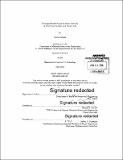| dc.contributor.advisor | Michael F. Rubner. | en_US |
| dc.contributor.author | Sample, Caitlin (Caitlin Sarah) | en_US |
| dc.contributor.other | Massachusetts Institute of Technology. Department of Materials Science and Engineering. | en_US |
| dc.date.accessioned | 2014-09-19T21:32:24Z | |
| dc.date.available | 2014-09-19T21:32:24Z | |
| dc.date.copyright | 2014 | en_US |
| dc.date.issued | 2014 | en_US |
| dc.identifier.uri | http://hdl.handle.net/1721.1/89980 | |
| dc.description | Thesis: S.B., Massachusetts Institute of Technology, Department of Materials Science and Engineering, 2014. | en_US |
| dc.description | Cataloged from PDF version of thesis. | en_US |
| dc.description | Includes bibliographical references (pages 28-30). | en_US |
| dc.description.abstract | Hydrogen-bonded multilayer thin films containing tannic acid (TA) and poly(vinyl alcohol) (PVA) were assembled under different pH conditions, and film growth and dissolution behavior was assessed through profilometry. Optimal film growth was achieved at pH 4.0, which contrasted with uncontrollable assembly at lower pH and lack of growth at higher pH. Changes in growth behavior due to variations in the molecular weight and degree of hydrolysis of PVA, as well as the concentration of the two components, were also investigated. High molecular weight PVA resulted in thicker films than low molecular weight PVA in two cases: fully hydrolyzed PVA at a concentration of 1.0 mg/mL and partially hydrolyzed PVA at a concentration of 0.1 mg/mL. In addition, the dynamic adsorption and desorption behavior of these films was investigated using QCM-D. The QCM-D results showed that each polymer immersion step involves both the deposition and removal of mass to and from the system, with the degree of removal determining the extent to which film assembly is successful. The pH stability of the PVA/TA films was higher than other previously investigated PVA based multilayer systems, which is consistent with the high pKa value of TA of 8.5. This increased pH stability, combined with the antioxidant, antimicrobial, antimutagenic, antitumor, and antibacterial properties of TA and the biocompatibility of PVA, makes the PVA/TA system attractive for biomedical applications, including drug delivery and sensing. | en_US |
| dc.description.statementofresponsibility | by Caitlin Sample. | en_US |
| dc.format.extent | 30 pages | en_US |
| dc.language.iso | eng | en_US |
| dc.publisher | Massachusetts Institute of Technology | en_US |
| dc.rights | M.I.T. theses are protected by copyright. They may be viewed from this source for any purpose, but reproduction or distribution in any format is prohibited without written permission. See provided URL for inquiries about permission. | en_US |
| dc.rights.uri | http://dspace.mit.edu/handle/1721.1/7582 | en_US |
| dc.subject | Materials Science and Engineering. | en_US |
| dc.title | Hydrogen-bonded layer-by-layer assembly of poly(vinyl alcohol) and tannic acid | en_US |
| dc.type | Thesis | en_US |
| dc.description.degree | S.B. | en_US |
| dc.contributor.department | Massachusetts Institute of Technology. Department of Materials Science and Engineering | |
| dc.identifier.oclc | 890129979 | en_US |
